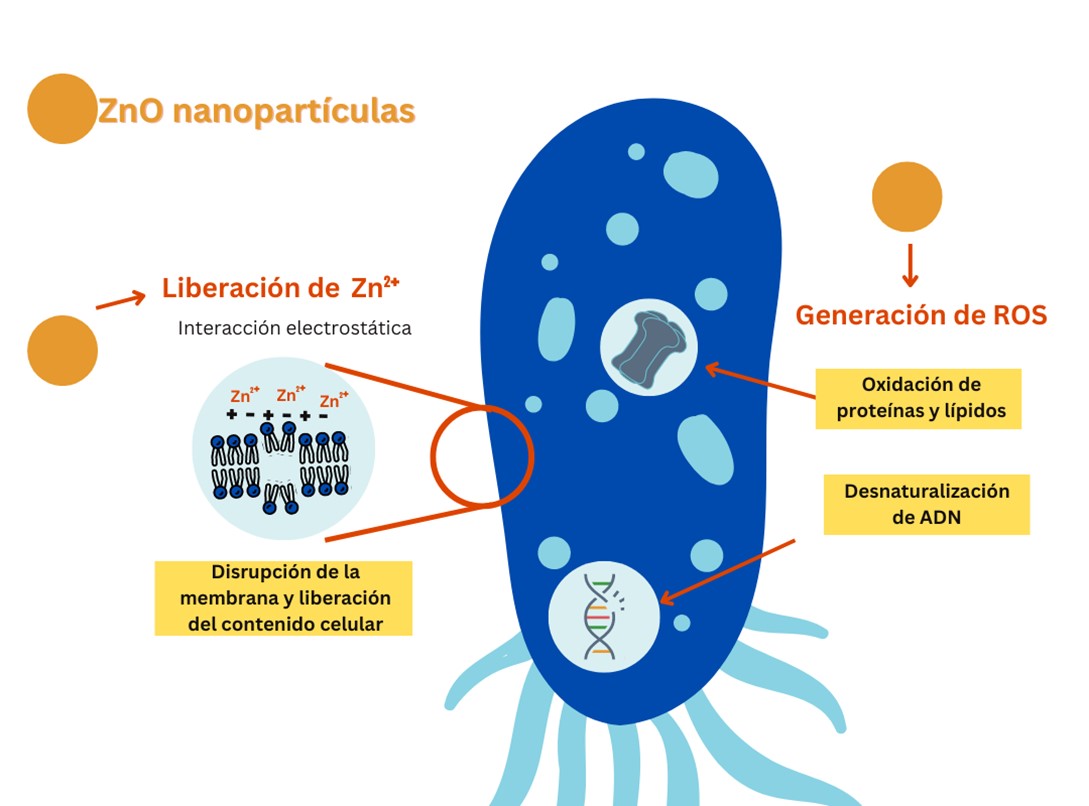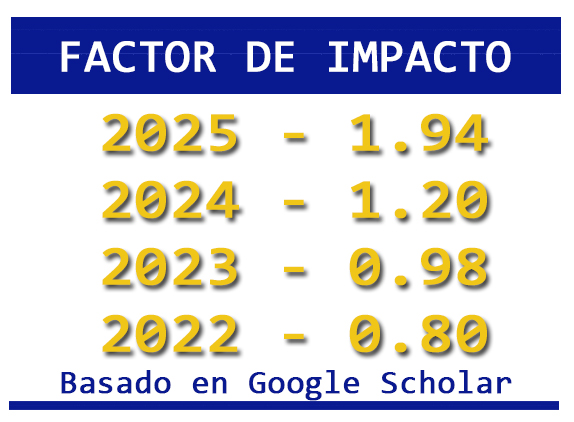Envases con películas de biopolímeros y nanopartículas antimicrobianas para frutas frescas cortadas
DOI:
https://doi.org/10.36790/epistemus.v18i37.388Palabras clave:
envase activo, nanocompuestos, polimeros biodegradablesResumen
Las frutas frescas cortadas, valoradas por su conveniencia y nutrientes, enfrentan retos significativos, como el rápido deterioro y contaminación microbiana tras su procesamiento mínimo. Una solución prometedora a estos problemas son los envases activos que utilizan películas y recubrimientos biopoliméricos como quitosano, almidón, alginato, entre otros. Estos recubrimientos no sólo son comestibles, seguros y sostenibles, sino que también pueden incorporar nanotecnología a través de nanopartículas metálicas antimicrobianas. Esto mejora las propiedades mecánicas y de barrera de los polímeros y ofrece una protección efectiva contra patógenos. Este artículo discute cómo la combinación de biopolímeros naturales con nanopartículas antimicrobianas está transformando el sector de envases comestibles, lo cual abre nuevas posibilidades para preservar la frescura y seguridad de las frutas cortadas.
Descargas
Citas
G. Singla, K. Chaturvedi y P. P. Sandhu, "Status and recent trends in fresh-cut fruits and vegetables," in Fresh-cut fruits and vegetables: Elsevier, 2020, pp. 17-49. DOI: https://doi.org/10.1016/B978-0-12-816184-5.00002-1
G. I. Balali, D. D. Yar, V. G. Afua Dela y P. Adjei-Kusi, "Microbial contamination, an increasing threat to the consumption of fresh fruits and vegetables in today’s world," International Journal of Microbiology, vol. 2020, 2020. DOI: https://doi.org/10.1155/2020/3029295. DOI: https://doi.org/10.1155/2020/3029295
G. Liguori, et al., "Effect of mucilage-based edible coating enriched with oregano essential oil on postharvest quality and sensorial attributes of fresh-cut loquat," Coatings, vol. 13, no. 8, pp. 1387, 2023. DOI: https://doi.org/10.3390/coatings13081387. DOI: https://doi.org/10.3390/coatings13081387
FDA. Draft guidance for industry: guide to minimize food safety hazards of fresh-cut produce. 2018. Disponible en: https://www.fda.gov/regulatory-information/search-fda-guidance-documents/draft-guidance-industry-guide-minimize-food-safety-hazards-fresh-cut-produce
R. D. Iturralde-García, et al., "Emerging technologies for prolonging fresh-cut fruits’ quality and safety during storage," Horticulturae, vol. 8, no. 8, pp. 731, 2022. DOI: https://doi.org/10.3390/horticulturae8080731. DOI: https://doi.org/10.3390/horticulturae8080731
W. Hu, Y. Guan, Y. Ji y X. Yang, "Effect of cutting styles on quality, antioxidant activity, membrane lipid peroxidation, and browning in fresh-cut potatoes," Food Bioscience, vol. 44, pp. 101435, 2021. DOI: https://doi.org/10.1016/j.fbio.2021.101435. DOI: https://doi.org/10.1016/j.fbio.2021.101435
M. C. Giannakourou and T. N. Tsironi, "Application of processing and packaging hurdles for fresh-cut fruits and vegetables preservation," Foods, vol. 10, no. 4, pp. 830, 2021. DOI: https://doi.org/10.3390/foods10040830. DOI: https://doi.org/10.3390/foods10040830
P. Zhao, J. P. Ndayambaje, X. Liu, and X. Xia, "Microbial spoilage of fruits: A review on causes and prevention methods," Food Reviews International, vol. 38, no. sup1, pp. 225-246, 2022. DOI: https://doi.org/10.1080/87559129.2020.1858859. DOI: https://doi.org/10.1080/87559129.2020.1858859
B. Yousuf, O. S. Qadri y A. K. Srivastava, "Recent developments in shelf-life extension of fresh-cut fruits and vegetables by application of different edible coatings: A review," LWT, vol. 89, pp. 198-209, 2018. DOI: https://doi.org/10.1016/j.lwt.2017.10.051. DOI: https://doi.org/10.1016/j.lwt.2017.10.051
R. J. Weisman, et al., "Estimating national exposures and potential bladder cancer cases associated with chlorination DBPs in US drinking water," Environmental Health Perspectives, vol. 130, no. 8, pp. 087002, 2022. DOI: https://doi.org/10.1289/EHP99. DOI: https://doi.org/10.1289/EHP9985
S. Bodbodak and Z. Rafiee, "Recent trends in active packaging in fruits and vegetables," in Eco-friendly technology for postharvest produce quality, M. W. Siddiqui, Ed. London: Elsevier, 2016, pp. 77-125. DOI: https://doi.org/10.1016/B978-0-12-804313-4.00003-7
L. K. Ncube, et al., "An overview of plastic waste generation and management in food packaging industries," Recycling, vol. 6, no. 1, pp. 12, 2021. DOI: https://doi.org/10.3390/recycling6010012. DOI: https://doi.org/10.3390/recycling6010012
J. R. Jambeck, et al., "Plastic waste inputs from land into the ocean," Science, vol. 347, no. 6223, pp. 768-771, 2015. DOI: DOI: 10.1126/science.126035. DOI: https://doi.org/10.1126/science.1260352
R. K. Deshmukh and K. K. Gaikwad, "Natural antimicrobial and antioxidant compounds for active food packaging applications," Biomass Conversion and Biorefinery, vol. 14, no. 4, pp. 4419-4440, 2024. DOI: https://doi.org/10.1007/s13399-022-02623-w. DOI: https://doi.org/10.1007/s13399-022-02623-w
M. Kostić, et al., "Edible coatings based on plant components for active packaging of fresh/fresh-cut fruits," South African Journal of Botany, vol. 161, pp. 395-403, 2023. DOI: https://doi.org/10.1016/j.sajb.2023.08.039. DOI: https://doi.org/10.1016/j.sajb.2023.08.039
F. Velázquez-Contreras, et al., "Cyclodextrins in polymer-based active food packaging: A fresh look at nontoxic, biodegradable, and sustainable technology trends," Polymers, vol. 14, no. 1, pp. 104, 2021. DOI: https://doi.org/10.3390/polym14010104. DOI: https://doi.org/10.3390/polym14010104
T. Janjarasskul and J. M. Krochta, "Edible packaging materials," Annual Review of Food Science and Technology, vol. 1, no. 1, pp. 415-448, 2010. DOI: https://doi.org/10.1146/annurev.food.080708.100836
E. Díaz-Montes and R. Castro-Muñoz, "Edible films and coatings as food-quality preservers: An overview," Foods vol. 10, no. 2, pp. 249, 2021. DOI: https://doi.org/10.3390/foods10020249. DOI: https://doi.org/10.3390/foods10020249
T. Senturk Parreidt, K. Müller y M. Schmid, "Alginate-based edible films and coatings for food packaging applications," Foods vol. 7, no. 10, pp. 170, 2018. DOI: https://doi.org/10.3390/foods7100170. DOI: https://doi.org/10.3390/foods7100170
L. Kumar, D. Ramakanth, K. Akhila y K. K. Gaikwad, "Edible films and coatings for food packaging applications: A review," Environmental Chemistry Letters, vol. 20, pp. 875–900, 2022. DOI: https://doi.org/10.1007/s10311-021-01339-z
H. M. Azeredo, C. G. Otoni y L. H. Mattoso, "Edible films and coatings–Not just packaging materials," Current Research in Food Science, vol. 5, pp. 1590-1595, 2022. DOI: https://doi.org/10.1016/j.crfs.2022.09.008. DOI: https://doi.org/10.1016/j.crfs.2022.09.008
P. Sharma, V. Shehin, N. Kaur y P. Vyas, "Application of edible coatings on fresh and minimally processed vegetables: a review," International Journal of Vegetable Science, vol. 25, no. 3, pp. 295-314, 2019. DOI: https://doi.org/10.1080/19315260.2018.1510863. DOI: https://doi.org/10.1080/19315260.2018.1510863
J. Ju, et al., "Application of edible coating with essential oil in food preservation," Critical Reviews in Food Science and Nutrition, vol. 59, no. 15, pp. 2467-2480, 2019. DOI: https://doi.org/10.1080/10408398.2018.1456402. DOI: https://doi.org/10.1080/10408398.2018.1456402
N. Chausali, J. Saxena y R. Prasad, "Recent trends in nanotechnology applications of bio-based packaging," Journal of Agriculture and Food Research, vol. 7, pp. 100257, 2022. DOI: https://doi.org/10.1016/j.jafr.2021.100257. DOI: https://doi.org/10.1016/j.jafr.2021.100257
T. H. Shellhammer and J. M. Krochta, "Edible coatings and film barriers," in Lipid technologies and applications: Routledge, 2018, pp. 453-479. DOI: https://doi.org/10.1201/9780203748848-17
M. Hoque, et al., "Biopolymer-based edible films and coatings for food applications," in Food, Medical, and Environmental Applications of Polysaccharides, I. B. Kunal Pal, Preetam Sarkar, Arindam Bit, Doman Kim, Arfat Anis, Samarendra Maji, Ed.: Elsevier, 2021, pp. 81-107. DOI: https://doi.org/10.1016/B978-0-12-819239-9.00013-0
S. Kumar, et al., "Biodegradable hybrid nanocomposite of chitosan/gelatin and green synthesized zinc oxide nanoparticles for food packaging," Foods vol. 9, no. 9, pp. 1143, 2020. DOI: https://doi.org/10.3390/foods9091143. DOI: https://doi.org/10.3390/foods9091143
Y.-S. Shyu, G.-W. Chen, S.-C. Chiang y W.-C. Sung, "Effect of chitosan and fish gelatin coatings on preventing the deterioration and preserving the quality of fresh-cut apples," Molecules, vol. 24, no. 10, pp. 2008, 2019. DOI: https://doi.org/10.3390/molecules24102008
P. J. Espitia and C. G. Otoni, "Nanotechnology and edible films for food packaging applications," in Bio-based Materials for Food Packaging, S. Ahmed, Ed. Singapore: Springer, 2018, pp. 125-145. DOI: https://doi.org/10.1007/978-981-13-1909-9_6
A. Ashfaq, et al., "Application of nanotechnology in food packaging: Pros and Cons," Journal of Agriculture and Food Research, vol. 7, pp. 100270, 2022. DOI: https://doi.org/10.1016/j.jafr.2022.100270. DOI: https://doi.org/10.1016/j.jafr.2022.100270
B. Kuswandi, "Nanotechnology in food packaging," in Nanoscience in Food and Agriculture, N. D. Shivendu Ranjan, Eric Lichtfouse, Ed. Switzerland Springer, 2016, pp. 151-183. DOI: https://doi.org/10.1007/978-3-319-39303-2_6
K. Kraśniewska, S. Galus y M. Gniewosz, "Biopolymers-based materials containing silver nanoparticles as active packaging for food applications–a review," International Journal of Molecular Sciences, vol. 21, no. 3, pp. 698, 2020. DOI: https://doi.org/10.3390/ijms21030698
W. Zhang, et al., "High performance biopolymeric packaging films containing zinc oxide nanoparticles for fresh food preservation: A review," International Journal of Biological Macromolecules, vol. 230, pp. 123188, 2023. DOI: https://doi.org/10.1016/j.ijbiomac.2023.123188. DOI: https://doi.org/10.1016/j.ijbiomac.2023.123188
M. A. Sani, et al., "Titanium dioxide nanoparticles as multifunctional surface-active materials for smart/active nanocomposite packaging films," Advances in Colloid and Interface Science, vol. 300, pp. 102593, 2022. DOI: https://doi.org/10.1016/j.cis.2021.102593. DOI: https://doi.org/10.1016/j.cis.2021.102593
H. Onyeaka, P. Passaretti, T. Miri y Z. T. Al-Sharify, "The safety of nanomaterials in food production and packaging," Current Research in Food Science, vol. 5, pp. 763-774, 2022. DOI: https://doi.org/10.1016/j.crfs.2022.04.005
H. Ahari, A. A. Anvar, M. Ataee y M. Naeimabadi, "Employing nanosilver, nanocopper, and nanoclays in food packaging production: A systematic review," Coatings, vol. 11, no. 5, pp. 509, 2021. DOI: https://doi.org/10.3390/coatings11050509
A. Ahmadi, P. Ahmadi y A. Ehsani, "Development of an active packaging system containing zinc oxide nanoparticles for the extension of chicken fillet shelf life," Food Science and Nutrition, vol. 8, no. 10, pp. 5461-5473, 2020. DOI: https://doi.org/10.1002/fsn3.1812
G. Ortiz-Duarte, L. E. Pérez-Cabrera, F. Artés-Hernández y G. B. Martínez-Hernández, "Ag-chitosan nanocomposites in edible coatings affect the quality of fresh-cut melon," Postharvest Biology and Technology, vol. 147, pp. 174-184, 2019. DOI: https://doi.org/10.1016/j.postharvbio.2018.09.021. DOI: https://doi.org/10.1016/j.postharvbio.2018.09.021
A. C. Flôr Vieira, et al., "Active coatings based on hydroxypropyl methylcellulose and silver nanoparticles to extend the papaya (Carica papaya L.) shelf life," International Journal of Biological Macromolecules, vol. 164, pp. 489-498, 2020. DOI: https://doi.org/10.1016/j.ijbiomac.2020.07.130. DOI: https://doi.org/10.1016/j.ijbiomac.2020.07.130
M. Lavinia, S. Hibaturrahman, H. Harinata y A. A. Wardana, "Antimicrobial activity and application of nanocomposite coating from chitosan and ZnO nanoparticle to inhibit microbial growth on fresh-cut papaya," Food Research, vol. 4, no. 2, pp. 307-311, 2020. DOI: https://doi.org/10.26656/fr.2017.4(2).255 DOI: https://doi.org/10.26656/fr.2017.4(2).255
K. Dulta, et al., "Development of alginate-chitosan based coating enriched with ZnO nanoparticles for increasing the shelf life of orange fruits (Citrus sinensis L.)," Journal of Polymers and the Environment, vol. 30, no. 8, pp. 3293-3306, 2022. DOI: https://doi.org/10.1007/s10924-022-02411-7. DOI: https://doi.org/10.1007/s10924-022-02411-7
A. Emamifar and S. Bavaisi, "Nanocomposite coating based on sodium alginate and nano-ZnO for extending the storage life of fresh strawberries (Fragaria× ananassa Duch.)," Journal of Food Measurement and Characterization, vol. 14, no. 2, pp. 1012-1024, 2020. DOI: https://doi.org/10.1007/s11694-019-00350-x. DOI: https://doi.org/10.1007/s11694-019-00350-x

Publicado
Cómo citar
Número
Sección
Licencia
Derechos de autor 2025 EPISTEMUS

Esta obra está bajo una licencia internacional Creative Commons Atribución-NoComercial-CompartirIgual 4.0.
La revista adquiere los derechos patrimoniales de los artículos sólo para difusión sin ningún fin de lucro, sin menoscabo de los propios derechos de autoría.
Los autores son los legítimos titulares de los derechos de propiedad intelectual de sus respectivos artículos, y en tal calidad, al enviar sus textos expresan su deseo de colaborar con la Revista Epistemus, editada semestralmente por la Universidad de Sonora.
Por lo anterior, de manera libre, voluntaria y a título gratuito, una vez aceptado el artículo para su publicación, ceden sus derechos a la Universidad de Sonora para que la Universidad de Sonora edite, publique, distribuya y ponga a disposición a través de intranets, internet o CD dicha obra, sin limitación alguna de forma o tiempo, siempre y cuando sea sin fines de lucro y con la obligación expresa de respetar y mencionar el crédito que corresponde a los autores en cualquier utilización que se haga del mismo.
Queda entendido que esta autorización no es una cesión o transmisión de alguno de sus derechos patrimoniales en favor de la mencionada institución. La UniSon le garantiza el derecho de reproducir la contribución por cualquier medio en el cual usted sea el autor, sujeto a que se otorgue el crédito correspondiente a la publicación original de la contribución en Epistemus.
Salvo indicación contraria, todos los contenidos de la edición electrónica se distribuyen bajo una licencia de uso y Attribution-NonCommercial-ShareAlike 4.0 International (CC BY-NC-SA 4.0) Puede consultar desde aquí la versión informativa y el texto legal de la licencia. Esta circunstancia ha de hacerse constar expresamente de esta forma cuando sea necesario.















